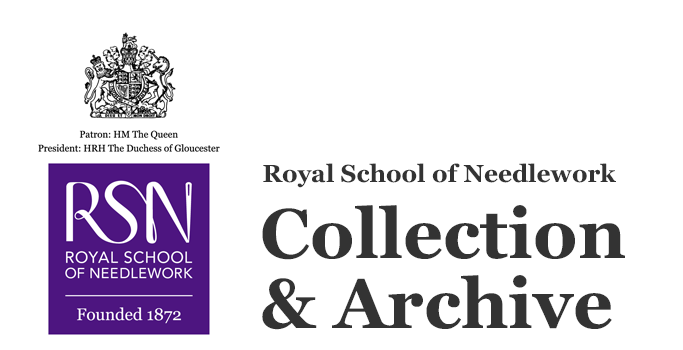Hanging
Object name
Date made
Late 19th century-early 20th century
Place made
Description
Hanging of an angel in goldwork and purple silk thread robes on a linen canvas ground, likely late 19th or early 20th century.
Content description
Late 19th or early 20th-century hanging with an angel in purple robes, holding a Tudor rose. The angel and background are worked in silk and metal threads on linen canvas, with the angel done in goldwork and the robes in stylised silk shading.
The wings, halo, background, parts of vestments, and a Tudor rose are done in couched gold thread, mostly passing thread. Twist is used on part of the Tudor rose. The wings, parts of the Tudor rose, and the fringing on the stole are created using guimped embroidery (strapping) to place the metal passing thread over the padding. Basketweave is done on the halo, the centre of the Tudor rose, and on the stole in a brick style, and on the collar and cuffs of the robes in a chevron pattern. The purple alb and fuchsia dalmatic worn by the angel are worked in silk threads in long and short stitch. The background is worked in metal passing thread couched down using the bricking method.
The face, neck, hair, and hands are painted and are further decorated with seeding stitches and satin stitch for the nails on the hands. The hands are heavily textured.
This is one of a trio of nearly identical hangings, known at the Royal School of Needlework as the 'Purple Angels'. The first Purple Angel was donated to the RSN in 2013 by a woman who had found it in the loft of a relative who was a vicar. It had been completed but was unmounted, and nobody in the parish knew of the piece when it was shown to them. The RSN mounted and framed the angel for it to be displayed during the ‘For Worship & Glory’ ecclesiastical exhibition at Hampton Court Palace in 2013. This angel is one of two that remains unframed in order to be able to study the hanging's reverse. The fact that is part of a trio suggests that it could have been intended as a triptych.
When working gold thread it is usually couched down with yellow thread that becomes invisible once applied, which is the case for the halo and the Tudor Rose here, but also visible on the hanging's reverse are green, red, and blue threads. The background at the top and bottom is couched with green, yet it still seems to blend in. It makes the gold look slightly darker, which aids in the overall three-dimensional look of the piece. Highly unexpected is the red thread which is behind the wings.
The design and needlework of this object are reminiscent of that seen on COL.2016.65.a, which may have been worked by the same individuals. It is not known exactly when, where, or for whom these ecclesiastical embroideries were made. Why all of these objects were never mounted or framed remains a mystery.
The wings, halo, background, parts of vestments, and a Tudor rose are done in couched gold thread, mostly passing thread. Twist is used on part of the Tudor rose. The wings, parts of the Tudor rose, and the fringing on the stole are created using guimped embroidery (strapping) to place the metal passing thread over the padding. Basketweave is done on the halo, the centre of the Tudor rose, and on the stole in a brick style, and on the collar and cuffs of the robes in a chevron pattern. The purple alb and fuchsia dalmatic worn by the angel are worked in silk threads in long and short stitch. The background is worked in metal passing thread couched down using the bricking method.
The face, neck, hair, and hands are painted and are further decorated with seeding stitches and satin stitch for the nails on the hands. The hands are heavily textured.
This is one of a trio of nearly identical hangings, known at the Royal School of Needlework as the 'Purple Angels'. The first Purple Angel was donated to the RSN in 2013 by a woman who had found it in the loft of a relative who was a vicar. It had been completed but was unmounted, and nobody in the parish knew of the piece when it was shown to them. The RSN mounted and framed the angel for it to be displayed during the ‘For Worship & Glory’ ecclesiastical exhibition at Hampton Court Palace in 2013. This angel is one of two that remains unframed in order to be able to study the hanging's reverse. The fact that is part of a trio suggests that it could have been intended as a triptych.
When working gold thread it is usually couched down with yellow thread that becomes invisible once applied, which is the case for the halo and the Tudor Rose here, but also visible on the hanging's reverse are green, red, and blue threads. The background at the top and bottom is couched with green, yet it still seems to blend in. It makes the gold look slightly darker, which aids in the overall three-dimensional look of the piece. Highly unexpected is the red thread which is behind the wings.
The design and needlework of this object are reminiscent of that seen on COL.2016.65.a, which may have been worked by the same individuals. It is not known exactly when, where, or for whom these ecclesiastical embroideries were made. Why all of these objects were never mounted or framed remains a mystery.
Dimensions
width: 41cm
length: 102cm
length: 102cm
Materials
Stitches
Seeding stitch 
Satin stitch
Long and short stitch
Couching
Basketweave (goldwork)
Bricking
Gold twist application
Guimped embroidery

Satin stitch

Long and short stitch

Couching

Basketweave (goldwork)

Bricking

Gold twist application

Guimped embroidery
Techniques
Motifs
Credit line
Gift of Marion Cantrell, 2013.
Catalogue number
COL.2013.64.a
Other numbers
RSN 2050
© Royal School of Needlework
